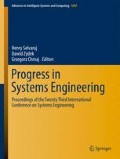Abstract
The problem of selecting the proper set of questions plays very important role in the domain of information retrieval, e.g., on the Internet, or about requirements during the business interview. In this work we propose a novel approach for selecting the sequence of binary questions to be asked to identify an unknown concept. This solution makes use of Restricted Boltzmann Machine (RBM) as a universal approximator of the distribution over the observable variables. The main idea of the proposed approach is to use RBM to determine transition probabilities in the evolving random process for finding the most suitable question to be selected. We evaluate the proposed approach on two reference datasets.
Access this chapter
Tax calculation will be finalised at checkout
Purchases are for personal use only
Notes
- 1.
Usually up to 20 questions. For that reason the game is called 20 questions game.
- 2.
In this text we associate the issue of discovering the values of features with problem of asking binary questions about the properties of the concepts.
- 3.
In some cases asking about the same thing more than once might be necessary, e.g., when a question is ambiguous and the answer cannot be correctly answered. However, we leave this issue for further research.
- 4.
Each of the elements of vector \( \pi \) is greater or equal 0.
- 5.
Two nominal features from the initial dataset were transformed to binary attributes.
- 6.
It was impossible to correctly distinguish all of the species with the given set of features.
- 7.
The dataset was initially used to detect e-mails with conference announcements.
References
Winston. http://kask.eti.pg.gda.pl/winston/20q.
20Q.net Inc. Q20 A. I. URL http://www.20q.net/.
K. Bache and M. Lichman. UCI machine learning repository, 2013.
Włodzisław Duch and Julian Szymański. Semantic web: Asking the right questions. In Proceedings of the 7 international conference on information and management sciences, pages 1–8, 2008.
Włodzisław Duch, Julian Szymański, and Tomasz Sarnatowicz. Concept description vectors and the 20 question game. In Intelligent Information Processing and Web Mining, pages 41–50. Springer, 2005.
Elokence. Akinator. URL http://en.akinator.com/.
Geoffrey E Hinton. A practical guide to training restricted boltzmann machines. In Neural Networks: Tricks of the Trade, pages 599–619. Springer, 2012.
Hugo Larochelle and Yoshua Bengio. Classification using discriminative restricted boltzmann machines. In Proceedings of the 25th international conference on Machine learning, pages 536–543. ACM, 2008.
Helena R Lourenço, José P Paixão, and Rita Portugal. Multiobjective metaheuristics for the bus driver scheduling problem. Transportation Science, 35(3):331–343, 2001.
J. R. Quinlan. C4.5: Programs for machine learning. Machine Learning, 16:235–240, 1994. 10.1007/BF00993309.
Jacek Rzeniewicz, Julian Szymański, and Włodzisław Duch. Adaptive algorithm for interactive question-based search. In Intelligent Information Processing VI, pages 186–195. Springer, 2012.
Ruslan Salakhutdinov, Andriy Mnih, and Geoffrey Hinton. Restricted boltzmann machines for collaborative filtering. In Proceedings of the 24th international conference on Machine learning, pages 791–798. ACM, 2007.
Julian Szymański and Włodzisław Duch. Information retrieval with semantic memory model. Cognitive Systems Research, 14(1):84–100, 2012.
Min Wang and Yong Zeng. Asking the right questions to elicit product requirements. International Journal of Computer Integrated Manufacturing, 22(4):283–298, 2009.
Acknowledgments
The research presented in this paper was partially supported by the European Union within the European Regional Development Fund program Number POIG.01.03.01-02-079/12.
© 2014 California Institute of Technology. Government sponsorship acknowledged.
Author information
Authors and Affiliations
Editor information
Editors and Affiliations
Rights and permissions
Copyright information
© 2015 Springer International Publishing Switzerland
About this paper
Cite this paper
Zięba, M., Tomczak, J.M., Brzostowski, K. (2015). Selecting right questions with Restricted Boltzmann Machines. In: Selvaraj, H., Zydek, D., Chmaj, G. (eds) Progress in Systems Engineering. Advances in Intelligent Systems and Computing, vol 366. Springer, Cham. https://doi.org/10.1007/978-3-319-08422-0_34
Download citation
DOI: https://doi.org/10.1007/978-3-319-08422-0_34
Publisher Name: Springer, Cham
Print ISBN: 978-3-319-08421-3
Online ISBN: 978-3-319-08422-0
eBook Packages: EngineeringEngineering (R0)

